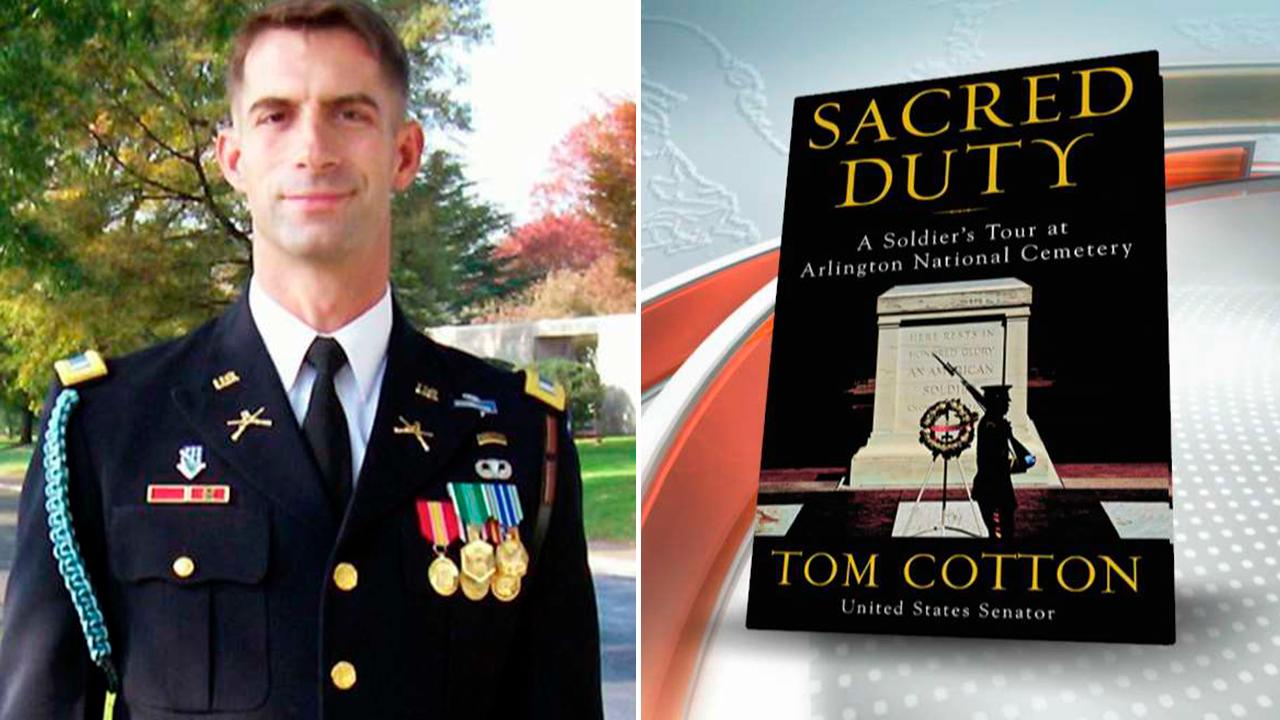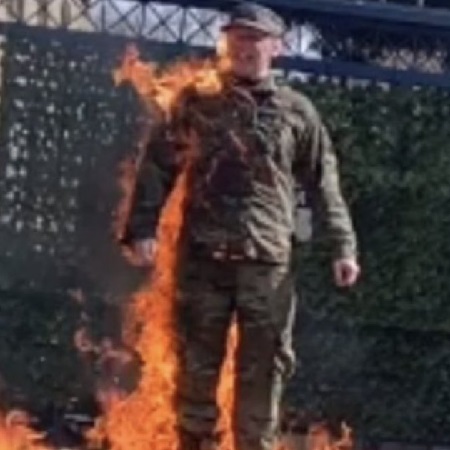
Senator Tom Cottton in uniform.
Sen. Tom Cotton Demands the Pentagon
Root Out Leftist Extremism in the Ranks
Ken Klippenstein / The Intercept
(March 7, 2024) — Aaron Bushnell’s death by self-immolation in front of the Israeli Embassy in Washington last month has provoked nationwide soul-searching about the war in Gaza. For the US government though, the airman’s death excites a different kind of search: for so-called extremists, particularly left-wing ones.
Last Wednesday, Sen. Tom Cotton, R-Ark., former Army officer and a member of the Senate Armed Services Committee, sent a letter to Defense Secretary Lloyd Austin asking why and how the Pentagon could tolerate an airman like Bushnell in its ranks. Calling his death “an act of horrific violence” that was “in support of a terrorist group [Hamas],” Cotton goes on to ask about the Defense Department’s internal efforts to address extremism and whether Bushnell was ever identified as exhibiting extremist views or behaviors.
Cotton’s agitation to find Hamas supporters in uniform twists Bushnell’s political act, which Bushnell said was in support of the Palestinian people. But it also follows a longstanding urging by other members of Congress like Sen. Chuck Grassley, R-Iowa — ranking Republican of the Judiciary Committee and former president pro tempore of the Senate — for the military to pursue some kind of similar treatment for leftists.

Aaron Bushnell in uniform.
DoD Fears Growing “Extremism” in the Ranks
While studies show that support for extremism is similar or even lower among veterans than the general population, extremism in the active-duty military has become an obsession of the Washington brass since January 6. Soon after taking office, new secretary of defense Austin, a retired Army general, directed the military to conduct an all-hands “stand down” to address extremism in the ranks, commissioning a number of panels and studies to evaluate white nationalism and neo-Nazi support among service members.
Outside of the Defense Department, the FBI is responsible for domestic counterterrorism. Since Israel’s war on Gaza began last October, it has been focused on any foreign blowback on the United States.
“In a year when the [foreign] terrorism threat was already elevated, the ongoing war in the Middle East has raised the threat of an attack against Americans inside the United States to a whole ‘nother level,” FBI Director Christopher Wray told cadets at West Point on Monday. “We cannot — and do not — discount the possibility that Hamas or another foreign terrorist organization may exploit the current conflict to conduct attacks here, on our own soil,” Wray told Congress right after the Gaza war began.
Will Bushnell’s death, and congressional pressure, open the door to build some speculative link between domestic supporters of Palestine and the bureau’s foreign-oriented anti-Hamas work?
Aaron Bushnell
Bushnell Vilified as an “Anarchist”
Though Bushnell’s suicide was intended to demonstrate his anguish over the plight of Palestinian civilians in Gaza, he also embraced anarchism, or at least a present-day articulation of anarchism that is a general rejection of established authority. Bushnell’s posts on Reddit and other social media platforms before his death reflected this embrace of anarchism, and he chose the anarchist symbol as his profile picture for the Twitch account he used to livestream his self-immolation.
His Facebook page also followed and liked pages for several anarchist groups. The anarchist collective CrimethInc. also said in a blog post that Bushnell had emailed the group shortly before his death.
Bushnell was also a community activist in San Antonio, Texas, where he was stationed. The Democratic Socialists of America San Antonio chapter issued a statement expressing solidarity with Bushnell and mentioning his work with them on homelessness. “He was an anarchist,” a San Antonio DSA member who interacted with Bushnell told The Intercept, asking that their name not be used. “He had a good nose for recognizing coercive / unhealthy organizing structures and practices; and was very intentional about his relationships with other people.”

The FBI’s Five “Threat Categories”
Since 2019, the FBI has used five “threat categories” to describe domestic terrorism: Racially or Ethnically Motivated Violent Extremism, Anti-Government or Anti-Authority Violent Extremism (AGAAVE), Animal Rights or Environmental Violent Extremism, Abortion-Related Violent Extremism, and “All Other Domestic Terrorism Threats,” which is defined as “furtherance of political and/or social agendas which are not otherwise exclusively defined under one of the other threat categories.”
The AGAAVE threat, the FBI says, “includes anarchist violent extremists, militia violent extremists, sovereign citizen violent extremists, and other violent extremists.” FBI data reveals that 31 percent of its investigations relate to AGAAVEs and 60 percent of all investigations include cases categorized as AGAAVE and “civil unrest.” Most of that focus since January 6 has been on groups that participated in the protests at the Capitol and supporters of Donald Trump.
Behind the scenes though, according to congressional testimony reported here for the first time, the FBI maintains a program specifically for combating anarchists, called the Anarchist Extremism Program. In Senate testimony, the FBI says that it had increased its targeting of anarchist “violent extremists” across the country by using both human and technical sources to spy on them.
Since the nationwide protests after the death of George Floyd in 2020, the bureau has tasked field offices to tap confidential informants to develop better intelligence about anarchists. In 2021, the FBI more than doubled its domestic terrorism caseload; and Wray told Congress that arrests of what the bureau calls “anarchist violent extremists” were more numerous in 2020-2021 (the months around January 6) than in the three previous years combined.
An internal FBI threat advisory obtained by The Intercept defines Anarchist Violent Extremists as individuals “who consider capitalism and centralized government to be unnecessary and oppressive,” and “oppose economic globalization; political, economic, and social hierarchies based on class, religion, race, gender, or private ownership of capital; and external forms of authority represented by centralized government, the military, and law enforcement.”
By the FBI’s definition, little of this applies to Bushnell’s own articulation of his political views, despite the anarchist label. But the airman’s protest fulfills the push by many Republicans and conservatives to get the FBI to equally focus on leftists. In a 2021 hearing, Grassley pushed for more investigations of those on the left, alluding to the bureau’s anarchist extremism program.
“Former Attorney General Barr stated that the FBI has robust programs for white supremacy and militia extremism, but a significantly weaker anarchist extremism program,” Grassley said to Wray. “How do you plan to make your left-wing anarchist extremism program as robust as your white supremacy and malicious extremism program?”

Pentagon Dismisses Suicide as “Extremism”
At a press briefing last Thursday that discussed Bushnell’s ties to anarchism, the Pentagon appeared to hint that his death might be considered an act of extremism.
“A review of Aaron Bushnell’s social media account indicates that he has some pretty strong anarchist views,” a reporter asked. “Under the Pentagon’s definition of extremists, would he fall under that?”
“I do think it’s fair to say that suicide by self-immolation is an extreme act,” Pentagon press secretary Brig. Gen. Pat Ryder replied, promising a “full investigation.”
Posted in accordance with Title 17, Section 107, US Code, for noncommercial, educational purposes.
